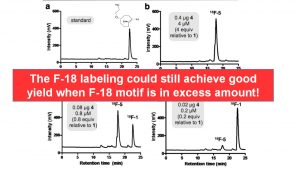Positron emission tomography (PET) is a powerful and rapidly developing technology that plays key roles in medical imaging, as well as drug discovery and development. Despite the exceptional promise of PET imaging, the availability of PET agents is limited in many situations due to the lack of efficient and simple labeling methods to modify biologically active small molecules/drugs. Because many small molecule pharmaceuticals and therapeutics contain aromatic or heteroaromatic systems within their framework, it is highly desired if radiolabels could be introduced to this common organic submit easily and efficiently. In collaboration with Prof. David Nicewicz at UNC Chemistry, we established an innovative photoredox method for PET probe construction. We continue the journal and hope to bring more labeling tools to the field.
Photoredox Radiolabeling Methods

There is a growing interest of developing bioorthogonal reactions that could be broadly useful tools with applications that span synthesis, chemical biology, and materials science. In collaboration with Prof Joseph Fox at U Del, we reported the 18F labeled TCO for PET probe construction in 2010. Thereafter, the toolbox keeps expanding and we are actively pursuing the labeling methods with Joe based on TTCO ligation.
TTCO Radiolabeling Methods
We are actively developing other new labeling methods including radioactive fluorescent dyes, new radiometal chelators, and more!!!
Other Radiolabeling Methods
Content Goes Here
Nanomedicine
Content Goes Here
Radionuclide based therapy
Content Goes Here
Translational Research
Content Goes Here
